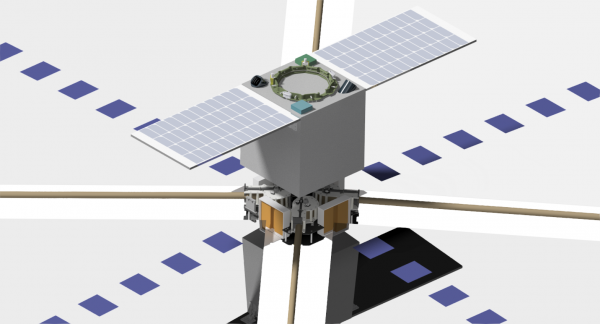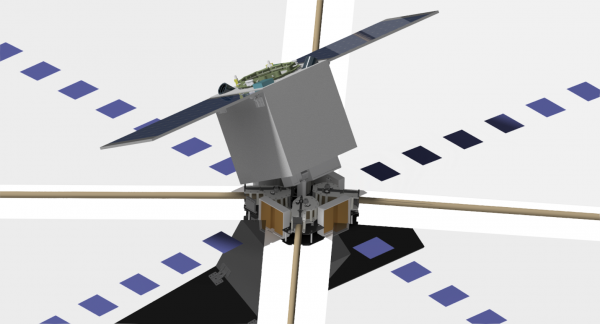The "Powered Innovative Earth-orbiter with Reorientable Inclined Sail" (PIERIS) was selected as part of the JAXA-Small Satellite Rush Program (JAXA-SMASH), an industry, academia, and government collaboration to realise small satellite missions and diversify transportation services. PIERIS has been undergoing feasibility studies, and has now been selected to move to the satellite development phase.
Figure 1: Artist image of the PIERIS micro solar sail
(Illustration by Institute of Science Tokyo, JAXA)
Here, we will introduce the research for the PIERIS project.
The JAXA-SMASH selection process
Solar sails are spacecraft that actively use the minute pressure from solar radiation acting on a large deployed sail to propel across space, allowing the spacecraft to change trajectory without the consumption of any propellant. This can greatly improve the propulsion performance of microsatellites that can only carry a small amount of propellent, and is expected to play an active role in deep space exploration, such as near the Moon or interplanetary journeys, in the future.
The micro solar sail project was selected for the feasibility study phase of the JAXA-SMASH Microsatellite Mission Call #2 in December 2023, and it was officially decided to transition to the satellite development phase after passing subsequent phase-up evaluations. The goal for the satellite development phase is to design, develop, and test a microsatellite with a weight below 40kg, with the completion date targeted at March 2027.
In preparation for the development, Professor Miyazaki Yasuyuki (Department of Space Flight Systems) and Professor Mori Osamu (Department of Interdisciplinary Space Science) at the JAXA Institute of Space and Astronautical Science have formed a collaborative research team with a group from Institute of Science Tokyo, which includes Associate Professor Chujo Toshihiro (Department of Mechanical Engineering), Specially Appointed Assistant Professor Watanabe Kei (Institute of Integrated Research, Quantum Navigation Research Center), Associate Professor Yatsu Yoichi (Department of Physics), Associate Professor Nakanishi Hiroki (Department of Mechanical Engineering), Assistant Professor Tomura Takashi (Department of Electrical and Electronic Engineering), and cosmobloom Inc. (CEO Fukunaga Momoko). Institute of Science Tokyo is primarily responsible for the mission and satellite system (including the integrated attitude-orbit control system), while the Institute of Space and Astronautical Science and cosmobloom Inc. will be primarily responsible for the sail deployment structure system.
The engineering of PIERIS
Conventional spacecraft need to consume propellent and expel gas to change (control) the spacecraft trajectory. The time needed and degree of acceleration for a trajectory change is therefore determined by the performance of the propulsion system, and the amount of propellant onboard. Solar sails have the advantage of not consuming propellent and if used effectively, can theoretically maintain trajectory control indefinitely, making solar sails effective for a variety of space missions. Simply by changing the orientation towards the Sun, a solar sail can alter its trajectory both away from and towards the Sun. However, because the pressure from solar radiation (※1) is minimal, the solar sail must be made as lightweight as possible to ensure the required amount of acceleration can be achieved.
Although the idea of solar sails has been around for a long time, it was the JAXA IKAROS mission that first successfully demonstrated interplanetary travel using a solar sail. Launched in 2010 together with the Venus Climate Orbiter, Akatsuki, the Small Solar Power Sail Demonstration Satellite, IKAROS unfurled a large, lightweight membrane measuring 14m on each side, with a thickness of 7.5 micron and a mass of about 15 kg. Outside Japan, sail membranes have been deployed on Earth-orbiting satellites, where the orbit is changed using solar radiation pressure, but not yet for interplanetary travel.
With the success of IKAROS, Japan acquired the technology to navigate with solar sails and deploy large membranes, but there remained one important issue that had to be addressed before full-scale deep space exploration with solar sails could be realized. This is the problem of unwanted rotational motion that occurs due to disturbance torques (※2) generated when the solar radiation pressure causes the sail membrane to deform. In order to cancel this rotational motion, propellant has to be consumed, which reduces the advantage of the solar sail. The presence of this issue was confirmed with IKAROS.
To tackle this issue, a mechanism is needed to minimize deformation of the large membrane and the lightweight supporting structure to ensuring high accuracy in the sail shape, as well as attitude control technology that can control both the impact of the disturbance torque on the solar sail attitude without using propellent, and control the trajectory at the same time. However, for extremely lightweight structures such as sail membranes, it has been suggested that it is difficult to achieve high shape precision as errors in the shape are likely to occur due to small inaccuracies during manufacturing, and the effects of the folds in the membrane that occur when the sail is stored before deployment. Moreover, the technology needed to simultaneously control attitude and orbit without propellant remains a concept.
In the JAXA-SMASH feasibility study, Professor Miyazaki and his team discovered that by shaping the sail membrane as a pyramid rather than a plane, it was possible to reduce the disturbance torque that would occur over the range of realistic manufacturing errors. The team also demonstrated a sail deployment structure to realize a pyramid-shaped sail, that is, a lightweight and superior deployment and a method for storing and deploying the sail membrane. Cosmobloom Inc., together with its partner companies, then revealed a highly accurate manufacturing method for such a sail deployment structure.
Associate Professor Chujo and his team also demonstrated that by mounting a gimbal between the satellite main body and the sail deployment structure so that the sail deployment structure can be fully rotated relative to the satellite main body (as shown in figure 2), it is theoretically possible to achieve integrated attitude-orbit control without any use of propellant (providing that the deformation of the sail membrane remains within a certain range). The idea of using a gimbal mechanism for control was inspired by demonstration satellite, Hibari with Variable Shape Attitude Control (launched in 2021), which was developed by the late Professor Matsunaga Saburo and colleagues at the former Tokyo Institute of Technology (now the Institute of Science Tokyo).
Figure 2: Image of the gimbal (illustration by Institute of Science Tokyo, JAXA )
The PIERIS Project aims to demonstrate these new technologies in space. The sail itself is 5m square, which is smaller compared to that of IKAROS, but this is sufficient for a feasibility study to demonstrate the technology.
In addition to these technology demonstrations, the Project will also conduct advanced technology demonstrations for future deep space exploration, including power generation experiments using a number of thin-film solar cells mounted on a sail, and orbit control experiments using a propulsion system that utilizes that generated electricity (hybrid propulsion combined with solar sail).
What lies ahead for the PIERS Project
Alongside conducting feasibility studies, our research team has been working with researchers from many universities and JAXA on deep space exploration using microsatellite solar sails, and we hope to continue these activities going into the future. If the PIERIS Project can demonstrate integrated altitude-orbit control and other advanced technologies, we believe that deep space exploration with solar sails will become a reality.
In addition, the high-precision sail deployment structure technology realized in the PIERIS Project are applicable to other applications, such as de-orbit devices for satellites after their operational period ends in order to address the problem of the build-up of space debris in Earth orbit, or to large membrane antennas for communication. We are planning to commercialize these devices in addition to solar sails.
※1 The pressure generated when photons emitted by the Sun collide with the surface of an object. The larger the surface area, the greater the force.
※2 A moment caused by an unexpected force (an action that tries to rotate an object).



